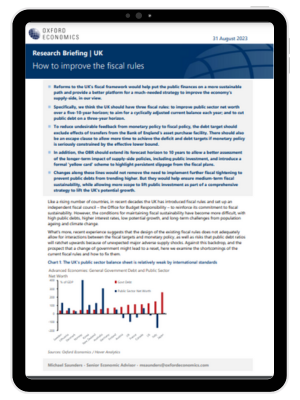How to improve the fiscal rules

Reforms to the UK’s fiscal framework would help put the public finances on a more sustainable path and provide a better platform for a much-needed strategy to improve the economy’s supply side, in our view.
Specifically, we think the UK should have three fiscal rules: to improve public sector net worth over a five-10-year horizon; to aim for a cyclically adjusted current balance each year; and to cut public debt on a three-year horizon.
To reduce undesirable feedback from monetary policy to fiscal policy, the debt target should exclude the effects of transfers from the Bank of England’s asset purchase facility. There should also be an escape clause to allow more time to achieve the deficit and debt targets if monetary policy is seriously constrained by the effective lower bound.
In addition, the OBR should extend its forecast horizon to 10 years to allow a better assessment of the longer-term impact of supply-side policies, including public investment, and introduce a formal ‘yellow card’ scheme to highlight persistent slippage from the fiscal plans.
Changes along these lines would not remove the need to implement further fiscal tightening to prevent public debts from trending higher. But they would help ensure medium-term fiscal sustainability, while allowing more scope to lift public investment as part of a comprehensive strategy to lift the UK’s potential growth.
Tags:
Related posts

Post
Trumponomics: The economics of a second Trump presidency
We modeled two scenarios in which former President Donald Trump returns to the White House and Republicans gain full control of Congress after the 2024 election.
Find Out More
Post
Navigating the US Economic and Real Estate Transition
This year is set to be a turning point for commercial property markets in the US. A gradual easing in inflationary pressures alongside a steady, if unspectacular, year for GDP and employment growth should help to ease the market through the final leg of the post-COVID adjustment.
Find Out More
Post
UK: Rethinking the UK’s fiscal rules is a key to unlock growth
Last week's Budget highlighted the flaws at the heart of the UK's dysfunctional fiscal policy, particularly its poorly-designed fiscal rules. We think reforming these rules would help to cut government debt, provide more support to growth, and reduce the scale of austerity that the next parliament will be forced into.
Find Out More